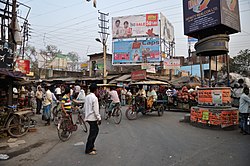Beldanga
Beldanga
Beldanga | |
|---|---|
Town | |
| Beldanga | |
 Barua Crossing, Beldanga | |
| Nickname: Beldanga | |
| Coordinates: 23°56′N 88°15′E / 23.93°N 88.25°E | |
| Country | |
| State | West Bengal |
| District | Murshidabad |
| Government | |
| • Type | Federal democracy |
| • Body | Beldanga Municipality |
| Area | |
| • Total | 3.98 km2 (1.54 sq mi) |
| Elevation | 20 m (70 ft) |
| Population (2011)[1] | |
| • Total | 29,182 |
| • Density | 7,300/km2 (19,000/sq mi) |
| Languages | |
| • Official | Bengali, English |
| Time zone | UTC+5:30 (IST) |
| PIN | 742133, 742189 |
| Lok Sabha constituency | Baharampur |
| Vidhan Sabha constituency | Beldanga |
Beldanga [বেলডাঙ্গা ]is a municipality town under the Berhampore subdivision of Murshidabad district in the state of West Bengal, India. Beldanga is an important trade centre of this district.
Geography
[edit]
5miles
River
River
River
River
M: municipal town, CT: census town, R: rural/ urban centre, H: historical centres
Owing to space constraints in the small map, the actual locations in a larger map may vary slightly
Location
[edit]Beldanga is located at 23°56′N 88°15′E / 23.93°N 88.25°E.[2] It has an average elevation of 20 metres (65 feet).
Area overview
[edit]The area shown in the map alongside, covering Berhampore and Kandi subdivisions, is spread across both the natural physiographic regions of the district, Rarh and Bagri.[3][4] The headquarters of Murshidabad district, Berhampore, is in this area.[5] The ruins of Karnasubarna, the capital of Shashanka, the first important king of ancient Bengal who ruled in the 7th century, is located 9.6 kilometres (6.0 mi) south-west of Berhampore.[6][7][8] The area is overwhelmingly rural with over 80% of the population living in the rural areas.[9]
Note: The map alongside presents some of the notable locations in the subdivisions. All places marked in the map are linked in the larger full screen map.
Demographics
[edit]According to the 2011 Census of India, Beldanga had a total population of 29,205, of which 14,694 (50%) were males and 14,511 (50%) were females. Population in the age range 0–6 years was 3,583. The total number of literate persons in Beldanga was 21,169 (82.62% of the population over 6 years).[10]
As per 2001 Census of India,[11] Beldanga had a population of 25,361. Males constitute 52% of the population and females 48%. Beldanga has an average literacy rate of 67%, higher than the national average of 59.5%; with 55% of the literates being male and 45% being female. 13% of the population is under 6 years of age.
Civic administration
[edit]Police station
[edit]Beldanga police station has jurisdiction over Beldanga municipal area and a part of Beldanga I CD Block.[12]
Infrastructure
[edit]According to the District Census Handbook, Murshidabad, 2011, Beldanga covered an area of 3.98 km2. It had 50.73 km roads with open drains. The protected water-supply involved overhead tank etc. It had 3,713 domestic electric connections, 1,556 road lighting points. Among the medical facilities it had 2 hospitals (with 55 beds).[13]
Transport
[edit]Beldanga railway station is well connected with Kolkata via Sealdah-Lalgola Division Railway. National Highway 12 passes through the Barua More, Beldanga town.
Education
[edit]Colleges
[edit]- S.R. Fatepuria College
- Beldanga Humayun Kabir Memorial B.Ed college
High school
[edit]- Swami Pranabananda Vidyapith (Girls)
- Beldanga C.R.G.S. High School
- Hareknagar A.M. Institution
- Harimati Girl's High School (Girls)
- Mirzapur H.S.C High School
- Banipith girls high school (Girls)
- Kazisaha High Madrasha
- KUMARPUR BHOLANATH MEMORIAL HIGH SCHOOL
- Beldanga Srish Chandra Vidyapith
- Sarat Pally Balika Vidyalay (Girls)
- Bishurpukur High School
Primary School
[edit]- Pranab Bharati School
- Sishu Niketan (Netaji Park)
- Madda Pranab Bharati
- Beldanga Path bhawan
- Kidzee Beldanga
- Mederdhar Shishu Madrasah
- Mederdhar Primary School
Healthcare
[edit]• Beldanga Rotary Eye Hospital
• Beldanga Anandalok Hospital
See also
[edit]References
[edit]- ^ a b "Beldanga City".
- ^ Falling Rain Genomics, Inc - Beldanga
- ^ "District Census Handbook: Murshidabad, Series 20 Part XII A" (PDF). Physiography, Page 13. Directorate of Census Operations, West Bengal, 2011. Retrieved 24 July 2017.
- ^ "Murshidabad". Geography. Murshidabad district authorities. Retrieved 24 July 2017.
- ^ "Murshidabad". Murshidabad district authorities. Retrieved 12 September 2017.
- ^ Ray, Nihar Ranjan, Bangalir Itihas Adi Parba, (in Bengali), 1980 edition, pp. 160-161, Paschim Banga Niraksharata Durikaran Samiti
- ^ Sengupta, Nitish, History of the Bengali-speaking People, p.25, UBS Publishers’ Distributors Pvt. Ltd.
- ^ Majumdar, Dr. R.C., History of Ancient Bengal, first published 1971, reprint 2005, pp. 5-6, Tulshi Prakashani, Kolkata, ISBN 81-89118-01-3.
- ^ "District Census Handbook, Murshidabad, Series 20, Part XII B" (PDF). District Primary Census Abstract page 26. Directorate of Census Operations West Bengal. Retrieved 2 July 2021.
- ^ "District Census Handbook, Murshidabad, Series 20, Part XII B" (PDF). Rural PCA-C.D. blocks wise Village Primary Census Abstract, location no. 801661, page 44-45. Directorate of Census Operations West Bengal. Retrieved 5 July 2021.
- ^ "Census of India 2001: Data from the 2001 Census, including cities, villages and towns (Provisional)". Census Commission of India. Archived from the original on 16 June 2004. Retrieved 1 November 2008.
- ^ "District Statistical Handbook 2014 Murshidabad". Table 2.1. Department of Statistics and Programme Implementation, Government of West Bengal. Archived from the original on 29 July 2017. Retrieved 17 May 2017.
{{cite web}}: CS1 maint: unfit URL (link) - ^ "District Census Handbook Murshidabad, Census of India 2011, Series 20, Part XII A" (PDF). Section II Town Directory, Pages 981-987: Statement I: Growth History, Pages 990-993: Statement III: Civic & Other Amenities, Pages 993-995: Statement IV: Medical Facilities 2009, Pages 995-1001 Section V: Educational, Recreational and Cultural Facilities; Pages 1 001- 1002: Statement VI: Industry & Banking. Directorate of Census Operations, West Bengal. Retrieved 26 June 2021.



